The events of the last two years changed a lot of things around the world. One of them was international travel. In the context of a deadly global pandemic the cancelling of surf trips through 2020 was minor, but travelling for waves is a core part of the surfing experience for many, and surf travel (a sub-industry in its own right) contributes to the livelihoods of many people around the world. Through 2020 and much of 2021 many surfers had to shift their mindsets to explore closer to home and make the most of what was on their doorstep, or within their own nation’s borders. Many found that it wasn’t actually so bad, and that sometimes there are more ways to enjoy and measure the success of a trip than by waves alone.
Some surfers have been operating like this for years, before the rest of the surf world was forced to take up their way of thinking. Now, with the world continuing to find its way through the COVID19 pandemic and many surfers taking or planning surf trips again, will “staycation” and alternative styles of surf trip retain their popularity?
Back in 2016, in a world BC (“before COVID”), two friends from the southwest of the UK with an equal passion for surfing and cycling undertook exactly the sort of surf trip that you wouldn’t want to rate based on surf success alone. They kitted their bikes out with trailers, strapped a surfboard across the top of each, and wheeled their steel steeds onto the ferry to Spain. 36 hours later they disembarked at the port at Santander, and set off in search of surf and place to pitch their tents. Sam and Nathan had a digital camera and a few single use film cameras stuffed into their panniers. They sweated up hills, camped in the woods, carried bottles of red wine in their water bottle cages, and generally had a great time. They did score fun waves, but it was about more than that. Here, Sam shares a few of their highlights:





